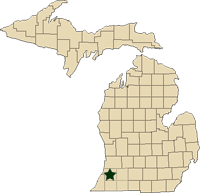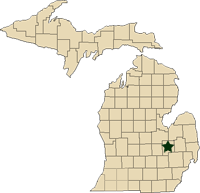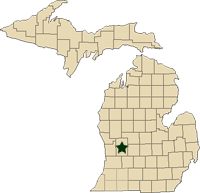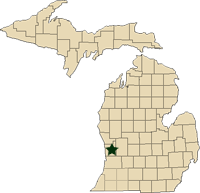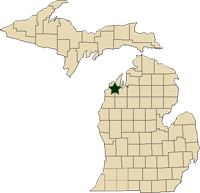Regional reports on Michigan fruit – April 24, 2012
MSU Extension educators’ pest and fruit updates for Michigan.
This week’s regional reports:
- Southwest Michigan - Mark Longstroth, Bill Shane, Diane Brown
- Southeast Michigan - Bob Tritten
- Grand Rapids Area Tree Fruit - Amy Irish Brown and Phil Schwallier
- Grand Rapids Area Small Fruit – Carlos García-Salazar
- Northwest Michigan - Nikki Rothwell, Duke Elsner, Erin Lizotte
Southwest Michigan – Mark Longstroth, Bill Shane, Diane Brown, Michigan State University Extension
|
Weather
Last week was a typical week in April with some warm days and frosty nights. Several days had temperatures reaching 70, but generally highs were in the 50s and 60s and most lows were around freezing. Little to no additional damage was reported as many areas had already suffered significantly in earlier freezes. Fruit sites with good air drainage are less affected. Last Friday (April 20) was wet and rainy, but most areas received less than a half-inch of rain. Soils are wet. Weather for this week is forecast to continue to be cool, with highs around 60 and lows in the 40s. There is a chance of rain most of the week with a cold and rainy weekend. Our growing degree day accumulations are about twice what they normally would be.
|
Southwest Michigan Growing Degree Day Totals from January 1 through April 22 | |||
|
Location |
GDD 42 |
GDD 45 |
GDD 50 |
|
578 |
473 |
322 | |
|
512 |
414 |
274 | |
Tree fruit
Friday’s cold rain was a marginal infection period for apple scab and cherry leaf spot for northern sites. Most sites did not have infections due to the cold temperature of the wetting period. The cool weather forecast will continue to inhibit plum curculio activity and egglaying. Tree foliage has greened appreciably in the past two weeks.
Apricots are 16 to 20 mm in diameter. Some growers report the interior of the fruit is brown, indicating the seeds are dead.
Peaches are at shuck split. Exposed fruit is 6 to 8 mm in diameter. There is still fruit at good peach sites. Peach leaf curl symptoms are appearing. Oriental fruit moth catches continued last week in spite of the cold weather. An average, 6.5 oriental fruit moth were trapped at the Benton Harbor trapping location, 12 at Berrien Springs and 11.5 at Covert. We think a new biofix of April 13 is justified based on the high trap numbers last week.
Tarnished plant bugs adults are present in orchards and are a concern when fruit starts emerging from the shuck. Growers using low rates of copper to inhibit bacterial spot should consider shifting to other materials such as mycoshield or Syllit plus Captan to avoid copper injury to peach foliage.
Sweet cherries are 8 to 12 mm in diameter. Generally, the crop is light and some orchards have only enough fruit to feed the birds. Bacterial canker symptoms are showing up, spotting on the leaves and collapsing spurs with gumming. Protectants for cherry leaf spot are needed. Cherry leaf spot infects the leaves through the stomates, so the disease can only infect expanded mature leaves that have functional stomates.
Tart cherries have emerged from the shuck. These rare fruit are 4 to 6 mm. There might still be some fruit in the shuck, but the crop is very sparse with only a few areas with adequate amounts. Growers should maintain controls for cherry leaf spot. Plum curculio egglaying activity will return with warm nighttime temperatures.
In plums, Japanese plums are 6 to 8 mm. European plums are emerging from the shuck. Growers need to protect against black knot. Tarnished plant bugs and plum curculios will be concerns if warm weather returns.
Apple bloom is ending. Fruit ranges from 3 to 7 mm at the Southwest Michigan Research and Education Center (SWMREC). Damage from recent freezes is widespread. Freeze injury to the leaves is very apparent in some orchards. Freeze-killed blossoms are falling. Apple scab symptoms are hard to find. They should be showing up in unsprayed orchards. Growers should check their orchards for scab.
Bloom has been too cool for fire blight. Powdery mildew symptoms are showing up in some orchards. Cool conditions, infrequent rain, and high humidity favor this disease. Traps for codling moth should be out and pheromone disruption should be put out soon for growers using this control approach. So far no codling moths have been trapped in orchards we monitor, but a few growers have reported trap catch. Other insects being trapped include redbanded leafrollers and spotted tentiform leafminers. No obliquebanded leafrollers have been trapped yet.
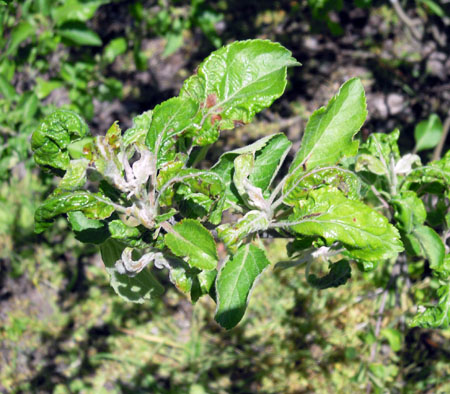
These crinkled and distorted apple leaves show the effects
of
several freezes down to the low 20s.
Pears are scarce. Harrow Sweet seems to have set a crop, but Bartletts are few and far between. Growers will need to protect against pear scab and watch for fire blight conditions.
Small fruit
Grapes. Concord and Niagara vineyards sustained widespread freeze injury, but new growth is beginning to develop. Sites with good air drainage suffered less damage. The pattern of freeze damage in a vineyard is getting easier to see. Green shoots are more noticeable in some vineyards. There are some primary and secondary buds pushing, but at some sites, little new growth can be seen associated with dead shoots from earlier damage.
Wine grapes generally suffered much less injury. With recent rains and warming temperatures, any exposed flower clusters will need protection against phomopsis. Low numbers of grape berry moth are being caught in traps, but we have not reached biofix.
Blueberry bloom continues. Many varieties began to open early last week. There are fields with no open flowers. We have a very heavy set of flower buds in most fields. Cool weather has kept many leaves red, but they should green up when we get warmer nights in May. Wind machines and overhead irrigation systems ran the last several nights. There is little additional damage from recent freezes. When good pollinating weather returns, growers should treat for the fruit phase of mummy berry at 25 percent and full bloom. Cranberry fruitworm traps should be out before bloom.
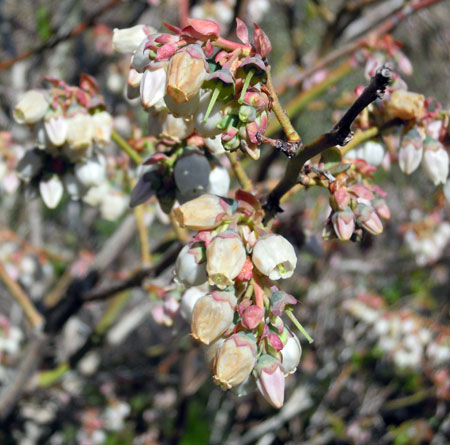
Browning of the petals on these blueberries indicates cold
temperatures, but the green styles on the fruit indicate that the
flowers were
not killed.
Strawberries are blooming and fields are very wet from all the freeze protection this last week.
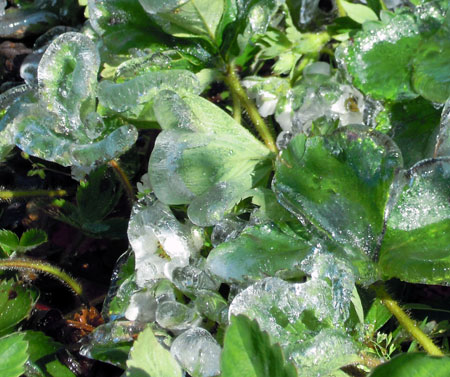
Ice encrusts strawberry leaves and flowers Monday morning (April 23).
Growers have made ice almost a dozen times this spring.
In brambles, flower clusters are visible in many varieties. Many plants show leaf scorching from recent freezes. Significant losses in blackberries (dead flower buds) have been reported and some early blooming red raspberries were also affected by the freezes.
Cranberry growers have also been irrigating for freeze protection almost every morning.
Upcoming meetings
Our next Monday fruit meetings will be April 30 at Fruit Acres Farms at 5 p.m.
The first Blueberry Twilight meeting is scheduled for May 2 at True Blue Farms south of Grand Junction, Mich. The cost for this meeting will be $10 at the door. Dinner will be provided and will start at 5:30 p.m. After dinner, there will be a review of post-bloom insect and disease management in blueberries, irrigation and other topics.
On-site registration will be available for the first in-season grape meeting, scheduled from 3 to 8 p.m. on April 25 at SWMREC, 1791 Hillandale Rd. Benton Harbor, Mich. (see map and directions). This meeting will feature sprayer calibration, rate controllers, and sprayer setup for early season canopies. There will also be discussion about adjusting insect and disease management programs for vineyards that have been frost damaged. Registration is $25, including supper. Contact the Berrien County Extension office at 269-944-4126.
A workshop on filtration for small wineries will be held on May 16 from 11 a.m. to 4 p.m. at Karma Vista Vineyards and Winery, 6991 Ryno Rd., Coloma, Mich. (see map and directions). This hands-on review of commercial, small-scale filtration techniques offers perspectives from wine industry suppliers, winemakers and researchers. There will be demonstrations and instruction on plate/frame, DE, membrane technologies, cartridge and crossflow, and bubble-point test. Registration fee, which includes lunch, is $70 for the first person from each winery; $30 for each additional person from each winery. Register online. This meeting is presented by Michigan State University and the Michigan Wine Foundation.
Southeast Michigan – Bob Tritten, Michigan State University Extension
|
Weather
Cool weather has kept fruit crops in a holding pattern over the last few weeks. We have experienced four more freeze events at many of our east Michigan reporting stations over the last two weeks, resulting in additional damage to flower buds. Low temperatures in the 23 to 27°F range have been reported from these freezes. Most areas have recorded eight to10 freeze events with temperatures below 30° since March 26, with Lapeer, Mich., reporting 12 freeze events. There has been extensive damage to flower buds with each one of these freeze events.
Our early, warm season is running close to three weeks ahead of normal in terms of growth stages, and even more than that in terms of degree day totals. We are generally vulnerable to frost and freeze events for the next three to four weeks.
Our soils remain warm for this time of the season, with soil moisture supplies generally running on the dry side for many farms. Planting of both tree and small fruits are well along this season.
|
East Michigan Growing Degree Day Totals for March 1 to April 23 | |||
|
Location |
GDD42 |
GDD45 |
GDD50 |
|
Commerce (Oakland) |
462 |
369 |
239 |
|
Emmett (St Clair) |
434 |
346 |
225 |
|
Flint (Genesee) |
499 |
404 |
272 |
|
Lapeer (Lapeer) |
493 |
402 |
271 |
|
Petersburg (Monroe) |
518 |
417 |
276 |
|
Pigeon (Huron) |
396 |
311 |
202 |
|
Romeo (Macomb) |
447 |
356 |
228 |
Tree fruits
Apples are mostly at petal fall. I am concerned that our pollination weather has not been good this season. Much of the bloom has a ragged look to it, this also concerns me in terms of fruit set. Leaves on apples continue to look sickly. Growers are looking ahead to some very difficult thinning decisions this season in apples.
The full extent of the freeze injury is still playing itself out, with a fair amount of fruit drop occurring over the weekend and early this week. At this writing (April 24) it appears that if I needed to place a percentage of flower bud loss, I would place it close to 50 percent. But there is great variability in damage across the region. However, there are enough viable apple flower buds for a full crop, with the outside chance of an adequate apple crop.
Insect pressure resumed the last two weeks for a few insects, while others remain in a state of confusion. Oriental fruit moth trap catch rose sharply starting late last week, with trap catch numbers averaging 23 per trap. I set a regional biofix for oriental fruit moth of April 19. Spotted tentiform leafminer adult trap catch has remained steady these past two weeks with 200 to 300 per trap. I have had no codling moth trap catch and no plum curculio sightings. Redbanded leafroller trap catch is down for the end of first generation adult flight. I am just starting to see a few aphid species, including apple grain aphid and woolly apple aphid. I am also just starting to see a few leafroller larva, including obliquebanded, redbanded and fruittree leafrollers. I am also seeing a few green fruitworm larva. Predators are starting to be found at low levels; these include green and brown lacewing adults, ladybird beetles, Stethorus beetles and fallacis mites.
Most fruit farms have had three to four apple scab wetting events in the past two weeks, for most none resulted in an infection period. I have not seen an apple scab lesions. We continue to catch apple scab spores at both of our monitoring stations with each wetting event. Growers need to keep an eye out for fire blight conditions as we finish off bloom in apples.
Pears are at fruit set for what fruit remain on the tree. The extent of the frost damage is now becoming more apparent, with a good number of freeze damaged buds dropping. We have had a significant crop loss in pears. Pear psylla adults continue to fly, with egg hatch occurring as well.
Peaches are at petal fall. Some peach varieties have had significant fruit drop in the last week. It is still too early to assess the damage in peaches. Much of the fruit that remains on the tree is not swelling in size, which is not a good sign. Oriental fruit moth catch rose sharply starting late last week, with trap catch numbers averaging 23 per trap. I set a regional biofix for oriental fruit moth of April 19.
Sweet cherries have two sizes of fruit on the tree at this time, some are at shuck split and others are much smaller and remain in the shuck. I am hoping that this smaller fruit does not drop early. I am surprised to see that a small percentage of fruit remains on the tree, escaping freeze damage. Most blocks of sweet cherries have had extensive flower bud damage. The bloom that was hanging on the bottom side of the branch seems to have pulled through the freeze event with less damage. Shuck split insect applications are being made.
Tart cherries are at petal fall. Almost half of the bloom was lost to freeze damage.
Plums remain at fruit set for European types and shuck split for Japanese types. Over half of the flowers that I have checked have been damaged on Japanese types and close to a third of the fruit buds damaged for European types.
Small fruits
Strawberryflower trusses have emerged from the crown, with some early bloom on the ends and edges of rows. Some strawberry farms have frost protected three to four times in the past week. Leaves continue look tough. Strawberry clipper feeding damage has been seen at one farm with little damage. Angular leaf spot disease symptoms have been seen in very low levels at several strawberry farms. Copper applications have also been made at a few farms for this disease. Growers need to do a thorough scouting for this disease in the next few days.
Raspberry leaves continue to emerge for summer fruiting types and new canes continue to emerge from the soil for fall bearing types. Many of the emerging canes and leaves were badly burned from the freeze events. These should recover nicely in a few weeks.
Blueberries are at 20 to 40 percent bloom for a few early varieties, with most varieties being at late pink bud. I am seeing a few varieties that have not moved ahead in the past two weeks in terms of flowering stage; it appears that they are sitting still at early pink bud. I have cut many blossoms in these blocks, and can see no visible flower bud damage. Time will tell on these varieties, but I am concerned about this lack of growth.
Grapes are at bud burst, with a good number of buds being burned back or damaged from the freeze. There is more freeze damage in grapes than I expected a few weeks ago.
Grand Rapids Area Tree Fruit– Amy Irish Brown and Phil Schwallier, Michigan State University Extension
|
Growth stages and weather
Tree growth continues to move very slowly through various stages. For apples, most varieties are in some stage of bloom or petal fall. Some of the earliest apple varieties are nearing 6 mm in diameter. Bloom was not very showy this year due to more leaves present than normal. Stone fruits are breaking out of their shucks.
There have been continued freeze and frost events over two weeks, with some added damage each time, but overall it still appears that there is the potential for a full apple crop. Despite the cool temperatures, we feel that pollination was adequate and bees worked as the weather allowed. There is some concern about fertilization and pollen tube formation in this cooler weather. Growers are advised to take it very carefully as they start to think about any thinning in apples. As stone fruits continue in their development, we should know in the next few weeks if fertilization was adequate to set fruits.
Apple scab
There was a significant wetting event around west Michigan on April 19 into April 20. All stations have had enough wetting at around 45 degrees to give us a scab infection, with the exception of the Hart Enviro-weather station data, which is just shy of enough wetting hours, but so close that hopefully you had a good cover on. Spore numbers were again not as I expected at 156 spores per rod. I now believe that it’s a factor of my monitoring site. Based on degree days base 32, we are most likely at 85 to 95 percent mature spores right now and from this I estimate that we have at least four more weeks of primary scab to deal with, so don’t let your fungicide covers slip.
Fire blight
With apple bloom open over the last week, we start the model for blossom blight predictions. The cool temperatures during bloom gave us no risk for blossom blight infection. It appears that we’ve made it through most of apple bloom with no risk for blossom blight infection.
Apogeeis best applied at king bloom petal fall, which many apple varieties are now past. It needs to go on soon if you haven’t already.
Insects
Insect activity continues to be very slow. There continues to be a few oriental fruit moths flying, but it’s been difficult to set a biofix yet. No reports of codling moth flight. Traps should be up for codling moth and oriental fruit moth at this time in tree fruits.
I continue to find a few aphids on terminals, both green apple aphids and rosy apple aphids. There are some obliquebanded leafroller feeding in terminals, and I’ve noticed that their development has been very slow.
There are some scattered reports of European red mites in some blocks which seems unusual with the very cool temperatures. Local scouts tell me that they saw some European red mite egg hatch back when it was very warm in March, but then they seemed to disappear. Now, there are some immatures present again. It is thought that there was some early egg hatch when March temperatures were in the 80s for several days, but that ended when cold weather returned. Now, we could be seeing another round of hatch of overwintering eggs. Another odd thing for the 2012 season.
For petal fall timings for insecticides, it appears that a delayed petal fall approach might be warranted for those blocks with no European red mite pressure. Our big target pest at petal fall is plum curculio and until some evenings hold at temperatures above 55 or 60°F, curculio is expected to remain inactive. Scout carefully for overwintering obliquebanded leafroller larvae in terminals as they are active in this cooler weather.
Grand Rapids Area Small Fruit– Carlos García-Salazar, Michigan State University Extension
|
Climatic conditions in the Grand Rapids, Mich., region remain variable with sudden changes in temperatures that are affecting the region’s main small fruit crops: blueberries, strawberries and raspberries. So far, most places in our area are experiencing nightly low temperatures reaching the upper 20s. Thus, small fruit growers have remained alert to prevent freeze and frost damage to their crops. From April 17-24, low temperatures in the entire west central region dropped below the freezing point for extended periods of time as shown in the table below.
|
Location |
Hours below freezing | |||||||
|
4/17 |
4/18 |
4/19 |
4/20 |
4/21 |
4/22 |
4/23 |
4/24 | |
|
2 |
4 |
2 |
5 |
1 |
||||
|
3 |
2 |
3 |
||||||
|
1 |
1 |
4 |
||||||
|
2 |
5 |
2 |
1 |
|||||
|
0 |
4 |
1 |
3 |
|||||
|
0 |
2 |
4 |
3 |
|||||
|
9 |
5 |
5 |
4 |
|||||
|
5 |
3 |
6 |
||||||
During this period, the longest freezing period occurred around Ludington and Mecosta. Around the main small fruit growing areas comprised by Hart, Belding, Kent City, Sparta, and West Olive, Mich., low temperatures have been lasting for two to four hours.
Regarding small fruit conditions as of April 24, strawberries continue growing and early varieties are in the early bloom stage. But growers are having hard time protecting their crop against freeze and frost damage. Growers are expending considerable time and resources in protecting their crops. So far, some growers are reporting more than 15 hours of frost protection since the crop was uncovered. Thanks to these practices, no damage has been reported.
Raspberries are also affected by these climatic conditions. Raspberries continue growing and only light damage from early freeze and frost events has been reported. However, as well as in the case of strawberries, they have been protected against low temperatures using the sprinkle irrigation system.
With respect to blueberries, the major small fruit crop in west central Michigan, they are in the early bloom stages. In most early varieties, between 10 and 30 percent of the flowers are already open. Mid- and late season varieties are in the late to pink bloom stage. Due to these relative advanced bloom stages, early season varieties are suffering considerable frost damage. A preliminary survey conducted on Monday, April 24, right after the frost protection system was turned off indicated that unprotected fields of Bluecrops around West Olive, Mich., suffered on average 28 percent flower damage, which includes complete damage to styles, stamens and ovaries in already open flowers. Flowers in the late pink stage suffered damage to stamens that, under a 20X hand lens, appear brown and withered. Healthy stamens look white and fleshy.
Conversely blueberries that were protected sustained on average 17 percent flower damage, but in most cases the damage was to the stamens that look brown after the frost. In these cases, styles and ovaries were fine. These observations were conducted in side-by-side fields, one protected and the other unprotected.
These preliminary results are not definitive since the risk for more freeze and frost events is still present. Furthermore, the intensity of the damage may vary from field to field and from one region to another.
Blueberry fields with light frost damage to stamens and styles may benefit from the application of gibberellic acid (GA) to supplement the lack of natural pollinators and get an additional protection against freeze and frost damage. MSU small fruit horticulturist Eric Hanson has shown that application of GA may decrease the impact of low pollination. GA applications results in greater retention of some parthenocarpic (seedless) fruit that would have dropped and also increases the size of berries without a full complement of seeds. GA can be applied in a single spray during bloom (80 gram active ingredient per acre) or two 40 g sprays, one during bloom and the second 10 to 14 days later. The commercial formulation of this product is marketed under different names; several GA products (ProGibb, GibGro, etc.) are labeled for highbush blueberries. Read more information on gibberellic acid use on blueberries.
For more information contact Carlos García-Salazar at 616-260-0671.
Northwest Michigan – Nikki Rothwell, Duke Elsner, Erin Lizotte, Michigan State University Extension
|
Weather report
The weather in the northwest has been cool during the day, and we continue to have frosty conditions in the overnight for many nights during the past week. The warmest temperature for the past week peaked at 59°F on Wednesday, April 18. These cool daytime temperatures have not been good for pollination, and very few bees have been flying during the past week. These cool temperatures have been coupled with extremely windy conditions, and as the wind is coming from the north, it has made temperatures feel even cooler than reported.
Cool daytime weather is predicted to continue for the coming week. Unfortunately, the frosty nights continue to reduce the crop in many of our fruits. Last Friday, April 20, we received about 1.5 inches of rain across the region with some areas reporting more while other locations received less rainfall. We have accumulated 395GDD base 42 and 204GDD base 50, and these accumulations are still way above our average (160GDD base 42 and 63.5GDD base 50).
Crop report
The cool temperatures have put crop development on hold in the past week, and the crops have not moved along much from last week’s report. Damage is evident across the region, and tart cherries have been hit the hardest. Some growers have reported tart cherries in the tops of their trees, but we will have to wait to see what comes out of the shuck before we know how much fruit we will have in northwest Michigan. Sweet cherries seemed to weather the frosty conditions better than tart cherries, but pollination has been an issue – we have had very few days that are conducive to honeybee flight. There is reported damage in apples across the region, and many king blooms have been killed by frost. However, there is still potential for a full apple crop if the side blooms have a good set; we are just moving into the bloom for apples, so we will not know the outcome for a few weeks.
Pest report
Cherries. As tart cherries bloom around the region, growers are considering the pros and cons of treating for American brown rot considering the crop damage over the past weeks. Even growers considering a conservative program due to crop loss should treat for the blossom phase of American brown rot as the flower parts can act as a reservoir for inoculum in subsequent years. Rovral is recommended for the spring American brown rot application in Montmorency. The use of Rovral will help limit the number of sterol inhibitor (SI) sprays used in a season and better manage against resistance. Rovral is also a nice fit at this timing as it cannot be used past petal fall. Growers with varieties that are extremely susceptible to European brown rot, such as Balaton and Meteor, are also encouraged to prevent infection as the impact of potential damage this season could affect the tree in coming years. Indar is the fungicide of choice for varieties susceptible to European brown rot as Rovral is not an effective European brown rot material. Indar will effectively protect against both American and European brown rot in all susceptible varieties.
Regardless of the crop load, growers should also plan to manage for cherry leaf spot and powdery mildew as green tissue emerges and becomes vulnerable to infection after bloom. Cherry leaf spot overwinters in fallen leaves on the orchard floor and produce ascospores (sexual spore) in the spring with dispersal occurring after a wetting event when temperatures are between 60 to 85°F. Following infection, acervuli (asexual spore-bearing structures) develop on the underside of the leaf and produce a visible mass of asexual spores called conidia. Spores are dispersed from leaf to leaf by wind or rain and this secondary infection cycle can be repeated several times within a season, depending on conditions. Keep in mind that cherry leaf spot is resistant to sterol inhibitor fungicides (Indar, Elite, Orbit) in all the major fruit producing areas of Michigan. Petal fall and shuck split applications of chlorothalonil are recommended.
Because of increased cherry leaf spot incidence and a minimal number of products to control this important disease of tart cherries, the Cherry Industry, Michigan State University, EPA, MDARD, and Syngenta have worked together to obtain a 24 (c) special local need registration (SLN) for use of Bravo Weather Stick (chlorothalonil) beyond shuck split. Traditional timing of chlorothalonil for cherry leaf spot has been prohibited past the shuck split timing prior to this newly registered use. With the 24 (c), growers must follow a series of restrictions in order to use this product legally throughout the growing season to ensure that post-shuck split applications do not result in illegal residues (less than 0.5 ppm). For more information, read “Tart cherries receive 24 (c) for use of Bravo Weather Stik (chlorothalonil) beyond shuck split.”
Bacterial canker is certainly a concern for growers as the cool weather returns and scattered snow and rain showers are predicted across the region. Unfortunately, there are no effective canker treatments at this time.
A few American plum borers were caught this week. Based on historical pest data, peak adult emergence of American plum borers has yet to occur. Growers should also be looking for obliquebanded leafrollers as leaves expand. Overwintering obliquebanded leafroller larvae feed inside bud clusters prior to bloom, and begin feeding on fruit after petal fall. Targeting this overwintering generation is critical in cherry because they are small and easier to kill. At early petal fall, growers should scout their orchards by looking at 20 clusters per tree in five trees per orchard for larvae or feeding sites. An insecticide should be applied if they observe more than two larvae or feeding sites per tree. The materials that target this life stage are Delegate, Belt, Altacor, Voliam flexi, Entrust and Bts. Growers in northwest Michigan should not expect organophosphates (OP) or pyrethroids to provide effective control because of insecticide resistance. If there is evidence of OP resistance in your area, the insect growth regulator Intrepid may also have some level of cross resistance and will not be effective.
Additionally, plum curculio activity should start picking up as soon as the temperatures increase. Adults will be migrating into orchards from overwintering sites, and they migrate from their overwintering sites to orchards in the spring when maximum temperatures are at least 75°F for two to three days or when mean daily temperatures are 55 to 60°F for three to six days. Plum curculio is often found in the orchard before fruit is present. Spring migration lasts about six weeks with peak activity and the critical time for control with organophosphates usually occurring two to three weeks after shuck split as young fruit develops.
Apples. Despite the rainfall, the temperatures were cold enough that the scab model did not predict an infection period but trees remain covered in the region as the risk is high for economic loss due to infections that occur at this time. EBDCs tank-mixed with Captan are the recommended protectant scab materials at this time in the season. EBDCs and Captan are both excellent scab protectants, and provide five to six days of protectant activity when used at full rates. Growers should remember that spray intervals should be tighter when relying on these materials. Growers should also keep in mind that strobilurin resistance has been confirmed in all major apple growing regions of the state and the mutation confers complete resistance —strobilurins will not work against apple scab and increasing the rate of a strobilurin is not an effective option. Regardless of crop load, growers should carefully consider their scab management program as inoculum can build quickly over a season and make control difficult in subsequent seasons.
Growers should be on the lookout for obliquebanded leafroller larvae feeding on terminals and can begin to gauge the potential for mites by scouting for eggs. Mites overwinter as eggs on rough bark and are most commonly found near buds, fruit spurs, and in the fork of two branches. They can be seen with the naked eye, but are very small so a hand lens is recommended. The red eggs of European red mite are visible at this time.
Grapes. Another week of cold weather has kept bud development at a slow pace in northwest Michigan. Some earlier sites have Chardonnay at late bud swell and earlier cultivars like Cabernet Franc heading into bud burst. There are still many buds that are just getting to the scale crack stage.
A little bit of grape flea beetle and climbing cutworm feeding injury has been seen, but the level of their activity has been quite low in our cold weather. The slow progression of buds is allowing for ample time to get on dormant applications for disease control.
I would like to hear back from vineyard managers if you are seeing any live buds that appear to have shrunk in size, perhaps from dehydration. The very unique weather patterns of this spring may bring along phenomena we have never seen before.
Saskatoons. Some sites are in full bloom now, but bee activity has been very limited in the cold and windy weather. Freeze injury to flower clusters and shoot tips was quite evident at the Northwest Michigan Horticultural Research Station test planting. No pest or disease activity has been noted.



 Print
Print Email
Email